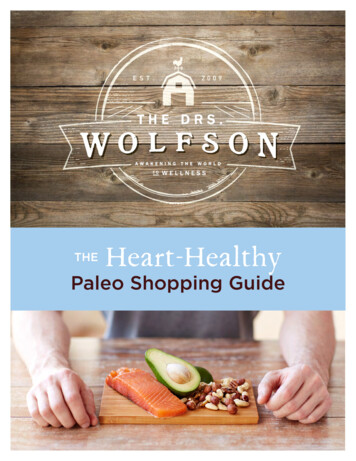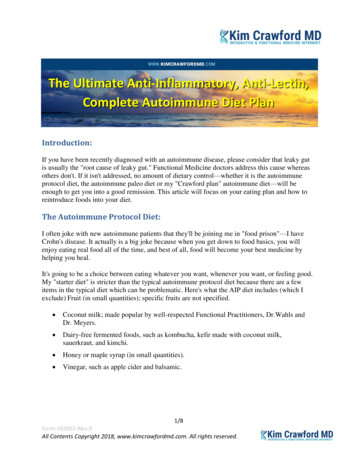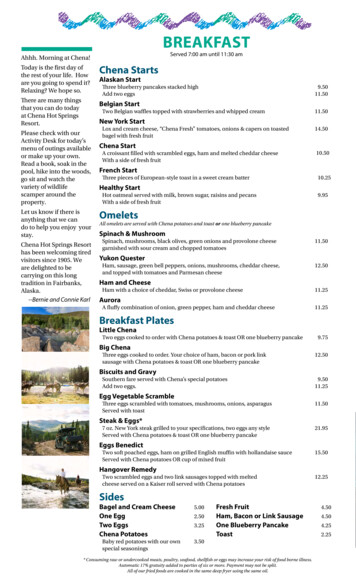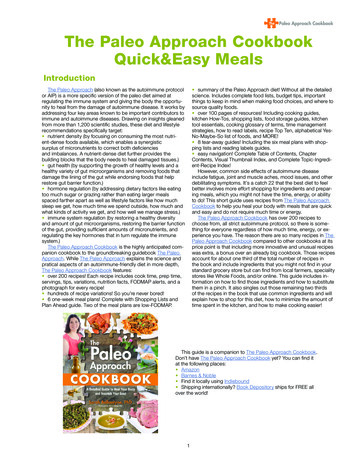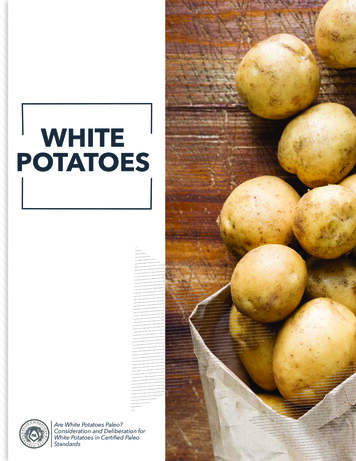
Transcription
WHITEPOTATOESAre White Potatoes Paleo?Consideration and Deliberation forWhite Potatoes in Certified PaleoStandards
TABLE OF CONTENTSPOTATOES 2016THE POTATOBIOLOGICAL FACTS7NUTRITIONAL FACTS8ARE POTATOES HEALTHY?STATEMENT OF PURPOSE3WEIGHTED INPUTS4EXPERTS5THE POTATO8GUT MICROBIOME7AUTOIMMUNE CONSIDERATIONS7ARE POTATOES SUSTAINABLE?MONOCULTUREARE POTATOES HEALTHY?9ARE POTATOES SUSTAINABLE? 10POTATO ARGUMENTS11CONSIDERATIONS9COMMUNITY ARGUMENTSPREAGRICULTURAL ARGUMENT9GLYCEMIC INDEX ARGUMENT10DISCUSSION16GLYCOALKALOID ARGUMENT10HIGHLY PROCESSED ARGUMENT11FINAL REMARKS16AUTHORITY ARGUMENT11CARBOHYDRATE ARGUMENT11CONCLUSION16 2016 The Paleo Foundation
STATEMENT OF PURPOSEIn loose terms, the Paleo Diet is a diet based on the types of foodspresumed to have been eaten by early humans before the advent ofagriculture. These foods included meat and seafood, nuts and seeds,roots and tubers, and fruits and berries. The diet of our ancientPaleolithic ancestors presumably excluded dairy, grains, and highlyrefined foods.Unfortunately, the food landscape has changed significantly in thepast 10,000 years, which makes defining items that fall into 21stcentury Paleo Diet a bit tricky. Because the diet is theoretical innature and up for wide interpretation, no single unified ‘Paleo Diet’definition exists, and disagreements over specific food items andprocessing among the Paleo Community is common.The purpose of the Consensus Reports for Paleo products is to offerproducers and Paleo Community members alike a more transparentview of The Paleo Foundation standards and procedures ofdeliberation.Karen PendergrassPaleo FoundationCEO 2016 The Paleo Foundation3
Consideration and Deliberation for White Potatoes in Certified Paleo StandardsSeptember, 2016WEIGHTED INPUTSThe Paleo Foundation Consensus Reports provide a comprehensivelook at how arguments made by the Paleo and Keto communities,leading experts, and the Paleo Foundation are weighted in creatingthe standards for the Certified Paleo and Keto Certified programsfor food products, highlighting The Paleo Foundation deliberationprocess.Our aim with the Paleo Consensus Report is to provide acomprehensive look at various arguments made by the PaleoCommunity, and to offer a definitive guide and current OfficialPaleo Status for foods and ingredients. We do so by taking severalfactors into account, including current research, archaeologicalrecords, paleogenetics, sustainability concerns, proposed healthbenefits, and input from various leading health experts of the PaleoMovement. The Paleo Foundation Consensus Reports serve asdefinitive, comprehensive, and current guides for foods and foodingredients.Logical ArgumentsCommunity ArgumentsExpert Input 2016 The Paleo Foundation4
THE EXPERTSChris Kresser M.S., L.AcMedicine For the 21stCenturyDr. Stephan GuyenetObesity Researcher,NeurobiologistDr. Sarah BallantyneAuthor of The PaleoApproachRobb WolfResearch Biochemist,Author of The PaleoSolutionAlan Aragon M.S.Nutrition Researcherand EducatorMark SissonTriathlete,Author of the PrimalBlueprintDiana Rogers, RDAuthor of SustainableDish 2016 The Paleo Foundation5
September, 2016Consideration and Deliberation for White Potatoes in Certified Paleo StandardsAre White Potatoes Paleo?Karen E. E. Pendergrass 2Community Arguments1Department of Standards, PaleoFoundation, Encinitas, CA1Email: karen@paleofoundation.comTwitter: @5wordsorlesskp11) White Potatoes weren’t eaten until the Agricultural Revolution.2) White potatoes aren't paleo because they have a high glycemic index.3) White Potatoes aren’t Paleo because they contain glycoalkaloids.4) White Potatoes aren’t paleo because they are consumed in highlyprocessed forms like french fries and potato chips.5) White Potatoes aren’t Paleo because they are Nightshades.6) White Potatoes aren’t Paleo because [a Paleo Expert] said they weren’t.7) White Potatoes aren’t Paleo because they are a high-carbohydrate food.KEYWORDSPaleolithic Diet, Carbohydrates, Glycemic Index (GI), Fallacy of Division,Ethnocentrism, Appeal to Authority1 BACKGROUNDSince the Paleo Diet [Appendix] was firstpopularized, the inclusion of potatoes in thediet has been perhaps the biggest source ofcontroversy within the Paleo community.white potatoes and offer additional input from leadingPaleo experts. In the conclusions of this report, we willoffer our decision to include or exclude white potatoesin the Certified Paleo Standards.The majority of Paleo community members ( anestimated 72%) believe that potatoes — including70white potatoes — are a Paleo food item. However,an estimated 27% of the Paleo community do notHowever, as a certification organization, The PaleoFoundation is tasked with making community-widedecisions regarding Paleo food items and mustconsider controversial ingredients, such as thepotato, carefully. In this Consensus Report, we willcritically examine arguments from the Paleocommunity on the topic of 2016 The Paleo FoundationCommunity Votesbelieve that potatoes are a Paleo food item, whileroughly 7% are unsure [Figure 1].52.53517.50YESNOMAYBEFigure 1. “Are Potatoes Paleo?” Poll conducted in the InternationalPaleo Movement Group (IPMG) September, 2016 [1].6
Consideration and Deliberation for White Potatoes in Certified Paleo Standards2 THE POTATOSeptember, 2016A. Biological FactsBotanical Family. Potatoes (Solanum tuberosum) are inthe Solanaceae family, related to tomatoes, peppers,and eggplant.Tubers. The part of the potato plant we eat is calledthe tuber, which is actually an enlarged undergroundstem. Each plant will produce multiple tubers. Potatotubers come in a variety of colors, but most commonare red and white. Their shape can be round, oblong,flattened, or elongated.Biodiversity. There are about 4,000 known varieties ofpotatoes with about 3,000 existing in the SouthAmerican Andes region alone where they originated,and can drastically differ in type, size, shape, color, andeven starch content [2]. Nutritional Facts“I think one of the biggest misperceptions aboutpotatoes is that they’re just a “carb bomb with nonutritional value” but the nutritional data suggestsotherwise.”- Diana Rogers(Karen Pendergrass,personal communication, September 13, 2016B.A large white potato (3” - 4 “ in diameter) (299g) has281 calories, contains 64.1 grams of carbohydrate, 7.9frams of protein, 6.9 grams of dietary fiber, and .4grams of protein [3].While the macronutrient profile of a potato is roughly88% carbohydrate, 10% protein, 10% dietary fiber and0.5% fat, nutritional data suggests that the whitepotato is also a very good source of essential vitaminssuch as vitamin C, niacin, vitamin B6, folate, andpantothenic acid, and minerals like magnesium,phosphorus, potassium, copper, and manganese [4][ Figure 2, 3 ] 2016 The Paleo FoundationFigure 2. A. Vitamins in a white potato. B. Minerals present in awhite potato. [4].7
Consideration and Deliberation for White Potatoes in Certified Paleo StandardsSeptember, 2016290 Calories0.4 Total Fat0 Saturated FatLow SodiumCholesterol FreeGood Source ofVitamin CGood Source ofDietary FiberSource of IronFigure 3. Nutrition Facts of large white potato [3]. 2016 The Paleo Foundation8
Consideration and Deliberation for White Potatoes in Certified Paleo StandardsSeptember, 2016“From a nutritional standpoint, potatoes have a badreputation, but this is undeserved in my opinion. If Ihad to pick a single food to eat exclusively for anAmylopectin is highly branched, leaving more surfacearea available for digestion. It’s broken down quickly,which means it produces a larger rise in blood sugarextended period of time, potatoes would be high onthe list. One reason is that they contain an adequateand subsequently, a larger rise in insulin. Amylose is astraighter chain, which limits the amount of surface areaamount of complete protein, meaning they don'thave to be mixed with another protein source as withgrains and legumes. Another reason is that a numberexposed for digestion. This is the dominant structure inResistant Starch. Foods high in amylose are digestedmore slowly, and are less likely to spike blood glucoseof cultures throughout history have successfully reliedon the potato as their principal source of calories,or insulin.and several continue to do so. A third reason is thatthey're eaten in an unrefined, fresh state.Therefore, it resists digestion in the small intestine andtravels on into the large intestine, where it becomes afood source, or prebiotic, for the bacteria that residePotatoes contain an adequate amount of manyessential minerals, and due to their low phytic acidthere. Thus, resistant starch is so named because itresists digestion.content, the minerals they contain are well absorbed.They're rich in magnesium and copper, two mineralsthat are important for insulin sensitivity andThe purpose for consuming resistant starch is to feedand cross-feed the healthy flora that live in your colon,cardiovascular health. They're also high in potassium,which helps control blood pressure, and vitamin C.so that they will multiply and regulate the gutmicrobiome [Appendix].Overall, they have a micronutrient content thatcompares favorably with other starchy rootvegetables such as taro and cassava, and they offer“Over the past several years there have been anexponential increase in the number of studies linkingconsiderably more micronutrients than refinedcarbohydrates such as white flour, white rice andimbalances or disturbances of the gut microbiota to awide range of diseases including obesity, inflammatorywhite sugar. [5]” - Stephan Guyenetbowel diseases, depression, and anxiety. One of thebest ways to establish and support a healthy gutmicrobiome is by providing the right “foods” or2 ARE POTATOES HEALTHY?prebiotics for your gut bacteria. Some common Paleofood sources of prebiotics include (unripe) bananas,plantains, and cooked and cooled potatoes. Resistant StarchStarch is a naturally occurring dietary carbohydrate.In plants its primary role is to store energy fromphotosynthesis in the form of long chains of glucoseso that it can be used later to fuel importantprocesses including seed germination.All starches are composed of two types ofpolysaccharides: amylose and amylopectin. 2016 The Paleo FoundationHowever, if you are on a low carbohydrate diet or don’ttolerate those foods well, you can add Resistant starchto your diet without adding digestible carbohydrates.Bob’s Red Mill Unmodified Potato Starch is one of thebest sources of RS with approximately eight grams ofRS in one tablespoon. Potato starch is generally welltolerated even by those who react adversely tonightshades.”- Chris Kresser [6]9
Consideration and Deliberation for White Potatoes in Certified Paleo StandardsSeptember, 2016 Autoimmune Considerations“Another reason for avoiding white potatoes is thatthey belong to the nightshade family [Appendix], agroup of vegetables that also includes tomatoes,eggplant, and peppers. Nightshades contain a type ofchemicals called glycoalkaloids [Appendix], that cantrigger leaky gut symptoms in people who areintolerant to them.One concern with aggressively supplementing withresistant starch, especially potato starch, is whathappens to the composition of your gut microbiome.Different strains of bacteria have specific substratesthey like to munch on, and while some are happy todine on [Resistant Starch], others prefer differentforms of fiber.When we consume unnaturally high (supplemented)levels of one type of resistant starch (or one type ofany fiber), we risk selectively feeding certain strains ofbacteria while lowering the proportion of otherbeneficial kinds. Even beneficial probiotic strains ofbacteria can overgrow, and this is especially a concernwhen this comes at the expense of microbial diversity—while much remains unknown about the optimumgut microbiome, one thing we know for sure is that adiverse microbiome is a resilient and healthy one.” Sarah Ballantyne [7]Although other countries also experienced the samefungal infection with their potatoes, the effectsweren’t as pronounced as they were in Ireland.Although the Irish Potato Famine devastated thenation for 3 years and killed nearly 1/8th of thepopulation, this was not because potatoes were aninherently inferior food source.What the Irish potato famine illustrated was afundamental danger associated with monoculturecrops, and what can happen when a single crop isrelied upon as a primary food source. Ireland reliedon potatoes as a staple food because the “IrishLumper” cultivar of potatoes were well-suited to thesoils and the climate, and could be grown in vastquantities [8]. It is speculated that a surplus ofcalories from potatoes allowed the population toboom. However, when the crop failed, the populationno longer had a reliable food source.Some potatoes are less susceptible to blight, and ifmultiple varieties of potatoes or other crops weregrown, the devastation may not have been sodramatic. Perhaps the Irish potato famine could havebeen avoided altogether. Today, pesticides andfungicides preclude most crop losses related toinfestation and fungal infection. However, chemicalinterventions and monocultures are not withoutfurther concerns.3 ARE POTATOES SUSTAINABLEIn 1845, a airborne fungal spore carried aboard a shipfrom the United States spread across Ireland within amatter of weeks, causing potatoes to turn black androt. At the time, Irish farmers almost exclusively grew“Irish Lumper” potatoes. So when the fungal diseasecaused by Phytophthora infestans struck theirpotatoes— it became a national disaster. 2016 The Paleo FoundationIn monoculture potato production, applications offungicides, single-species crop production, and tillingmethods negatively impact topsoil and disruptmycorrhizae [Appendix], reducing the nutrient andwater absorption capacity of the soils. To producemore nutritious food, protect biodiversity, andimprove soil profiles, other methods of potatoproduction that include biological fungicides andpesticides that do not adversely affect soil microbiotashould be explored.10
September, 2016Consideration and Deliberation for White Potatoes in Certified Paleo Standards POTATO ARGUMENTSIn order to begin to make critical assessments of theOfficial Paleo Status of the potato, individualarguments against its inclusion must be criticallyassessed. Given that the Paleo Diet is a theoreticaltemplate, logic must be employed as well whenmaking determinations for an entire community. Potatoes weren’t eaten until the AgriculturalRevolution.Today there are 151 species of wild potato, progenitorsof today’s cultivated potato [9]. Wild species of potatoexist in diverse soils and climates, and are mostlyconcentrated in South America where potatoesoriginated.Although the potato was first cultivated in SouthAmerica between 7,000 and 9,000 years ago, researchsuggests they grew wild in the region over 13,000 yearsago [8]. Evidence of the use of the potato in pre-IncaFigure 4. Elderly Aymara woman with wild potatoes.USAcultures exists in ancient altiplano Indian pottery (Nazcaand Chimú), dating back to 8,000 years ago, suggestingthe possible consumption of potatoes well before theagricultural revolution in the Americas.Thus, theargument that potatoes weren’t eaten until theagricultural revolution is inaccurate, and a poorargument against the inclusion of the tuber in the PaleoDiet.Of note, the Aymara are a potato-dependent andindigenousindigenous people who span Peru,northern Chile, and western Bolivia [Figure 5]. Andwhile potatoes are hypothesized to increase insulinresistance and risk of type 2 diabetes [10], cases ofdiabetes were remarkably low at 1.5%, while prediabetes was 3.6%, even among the elderly, despite thehigh overweight population among the Aymara [11][Figure 5]. 2016 The Paleo FoundationAymara3025Prevalence (%)420151050DiabetesPre-DiabetesFigure 5. Diabetes and Pre-Diabetes among Aymara vs theUnited States. Stephan Guyenet WholeHealthSource.com. [11].11
Consideration and Deliberation for White Potatoes in Certified Paleo StandardsSeptember, 2016 White potatoes aren't paleo because they have ahigh glycemic index. Potatoes aren’t Paleo because they containglycoalkaloids.Glycemic Index100Glycoalkaloids are natural pesticides produced bynightshade plants, and exist as a defensemechanism to deter predation from bacteria, fungi,viruses, insects, and humans. Glycoalkaloids arebitter compounds which are found throughout theplant, but their concentrations are especially high inleaves, flowers, and unripe fruits [16].7550250Boiled WhitePotato1Snickers Candy Bar 2Boiled SweetPotato 3Baked SweetPotato 4Figure 6. 1. Glycemix Index for various food items. 1[12];[14],42[13];3[15].According Figure 7, different varieties of potatoescontain different levels of glycoalkaloids, and theconcentrations differ between the peel and theflesh of the potato.The implications of thesefindings suggest that concerns about glycoalkaloidload can be mitigated by peeling, and choosingpotatoes with low glycoalkaloid content may evenbe safe for those with autoimmune conditions.The relevance of the dietary glycemic index (GI)[Appendix] has long been hotly debated. While someorganizations still support the concepts, many healthprofessionals consider GI too variable and unreliablefor use in clinical practice.For example, Figure 6 plots the glycemic index usinginformation of various foods. In this graph, bakedand boiled sweet potatoes, which are almostuniversally recognized Paleo foods, have a higherglycemic load than a Snickers candy bar, and a whitepotato.If high glycemic index is a factor in determining thePaleo Status of potatoes, then sweet potatoes andother officially recognized Paleo Foods could noFigure 7. Glycoalkaloid content of Selected Potato Varieties.Potato Glycoalkaloids and Metabolites: Roles in the Plant andin the Diet. Journal of Agricultural and Food Chemistry [16].longer be classified as Paleo. Thus, glycemic indexmay not be a good determining factor for the Paleostatus of white potatoes. 2016 The Paleo Foundation12
Consideration and Deliberation for White Potatoes in Certified Paleo StandardsSeptember, 2016Although nightshades contain glycoalkaloids, theyare not the only generally recognized Paleo foodswhich contain them: Cherries, apples, and beets alsocontain amounts of glycoalkaloid. The two most toxicand present glycoalkaloids in potatoes are called αsolanine and α-chaconine.If glycoalkaloid content were to determine the Paleostatus of foods, cherries, apples, beets, and othergenerally recognized Paleo Diet foods would also nolonger be considered paleo.Thus, Glycoalkaloidcontent may not serve as a good determining factorfor the Official Paleo Status of Potatoes, and is a poorargument against the inclusion of white potatoes.Although glycoalkaloids may not be a deterministicfactor in deciding the Official Paleo Status ofPotatoes, they may be a concern for anyone withchronic inflammation, as glycoalkaloids can increaseintestinal permeability, and can potentially amplifyimmunoligical responses [17]. Potatoes aren’t paleo because they are consumedin highly processed forms like french fries andpotato chips.One piece of evidence which has often been citedas a means to indemnify the potato may perhaps dothe exact opposite. Figure 8 suggests is thatglycoalkaloid content of potatoes is significantlyhigher with different methods of processing, andwhen the skins are present in the end-product.Figure 8. Concentrations of total glycoalkaloids ( α-chaconineand α-solanine ) in a variety of potato foods. [16].“Because most Americans eat the highly processedversion of the white potato—for instance, french friesand potato chips—consumption of this rootvegetable has been linked to obesity and anincreased diabetes risk [14].It also suggests that peeled potatoes are relativelyinnocuous compared to their processedcounterparts, giving weight to the argument that it’snot the potato itself that is the culprit, but ratherMeanwhile, sweet potatoes, which are typically eatenthe processing itself.a lower glycemic index than their white potatocounterparts. 2016 The Paleo Foundationwhole, have been celebrated [among Paleo Dietadherents] for being rich in nutrients and also having13
Consideration and Deliberation for White Potatoes in Certified Paleo StandardsWhat science really shows is that white potatoes andsweet potatoes have complementary nutritionalSeptember, 2016 P o t a t o e s a re n ’t P a l e o b e c a u s e t h e y a reNightshades.differences; one isn’t necessarily better than theother. For instance, sweet potatoes have more fiberand vitamin A, but white potatoes are higher inessential minerals, such as iron, magnesium, andpotassium.One argument against the addition of nightshades intothe Paleo Diet stems from the fact that nightshades,As for the glycemic index (GI), sweet potatoes are1492,lower on the scale, but this is inconsequential in thelarge scheme. GI has been shown to lack functionalimpact (even on glucose control) once you matchfiber and macronutrition between the dietscompared. The health advantages of low-GI diets arelargely attributable to a higher protein and fibercontent. Once those variables are controlled, GI'sutility becomes trivial to meaningless.The bottom line, the form in which you consume apotato—for instance, a whole baked or boiled potatoversus a processed potato that’s used to make chips—is more important than the type of spud.” AlanAragon [18]Although the argument against certain forms ofprocessing potatoes is valid, the argument whichsuggests that because a potato chip is unhealthy, thatthe potato itself must be unhealthy commits thelogical fallacy of division [Appendix].For example, sweet potatoes can be prepared in ahighly processed form just as easily as a white potatocould. Under this same line of reasoning, we couldsuggest that the more available processed sweetpotatoes become, the less “Paleo” the sweet potatoitself, becomes.members of the botanical Solanaceae family, camefrom the Americas and were not “discovered” untilNot only is this a very ethnocentric argument, it grosslyundermines the fact that hunter-gatherer peoplesoccupied the Americas as long as 15,500 years ago andlikely consumed nightshades, such as peppers,tomatoes, goji berries, and eggplant [19].By this same line of reasoning, it could be suggestedthat all fruits, vegetables, and animals indigenous tothe Americas would not be considered Paleo, includingNorth American bison.The argument against nightshades such as potatoesbeing excluded in the Paleo Diet because Paleolithicman did not eat them is a poor argument because it isfalse. Potatoes aren’t Paleo because [a Paleo Expert] saidthey weren’t.In the case of potatoes, it an oft-cited appeal toauthority is stated the following form: “Person A sayspotatoes are not Paleo, therefore this is true becausePerson A is an expert.”Unfortunately, the authority on a subject may notThus, the “Potatoes aren’t paleo because they areconsumed in highly processed forms like french friesand potato chips” is a poor argument for whypotatoes should not be included in the Paleo Diet. 2016 The Paleo Foundationalways be right, especially if the line of reasoning tomake the assertion is fallacious. And, to argue thatsomething is necessarily true [Appendix] becausesomeone says it is true commits the argument fromauthority fallacy.14
Consideration and Deliberation for White Potatoes in Certified Paleo StandardsSeptember, 2016Therefore, it would be illogical to conclude thatAccording to Staffan Lindeberg’s studies of thepotatoes are not Paleo because an expert —however popular — came to such an opinion. Thus,the “Potatoes aren’t Paleo because [a Paleo expert]Kitavans, they do not experience cardiac death, stroke,hypertension, or obesity even though an estimated80% of the population smokes regularly, and havesaid they aren’t” is a poor argument against theinclusion of potatoes in a Paleo Diet.remarkably low activity levels [21]. Potatoes aren’t Paleo because they are a highcarbohydrate food.“Chimps have been known to use sticks to dig up andeat wild tubers, and they’ve got even less salivaryamylase to break down starch than we [humans] do.Evidence exists for human consumption of roots andtubers from multiple sites spanning multiple timeperiods: Northern Europe (specifically Poland), in theterminal Paleolithic and early Mesolithic. Clearly, weAlthough the Kitavans do not traditionally consumewhite potatoes, the carbohydrates which they doconsume do not seem to impart adverse healtheffects. Nevertheless, the line of reasoning whichsuggests that carbohydrates are not Paleo would alsorender foods such honey as non-Paleo food itemsdespite a rich and well documented history of theirprehistoric, and Paleolithic consumption [22] .Thus the argument against potatoes on the basis ofcarbohydrate content is a poor argument against theinclusion of potatoes in a Paleo Diet.have the physiology (amylase production, glucosemetabolism), the tools, and the motivation (attractionto dense caloric sources with negligible or easilyneutralized anti-nutrients) to consume starchy tubers.A human metabolic tabula rasa can handle allmacronutrients in whole food form without metabolicdysfunction. That’s why you get folks like the Kitavanseating a high starchy tuber diet with excellent healthand fit figures.” - Mark Sisson [20]The Kitavans [Figure 9] are a group of traditionalhunter-gatherers who live on the island of Kitava, anisland of Papua New Guinea. The Kitavans almostexclusively consume a diet of universally acceptedPaleo foods such as fish, yams, sweet potatoes, andtaro. The astonishing macronutrient composition ofthe Kitavan diet is estimated to be 20% fat, 10%protein, and 70% carbohydrate.Figure 9. Male Kitavan. Photocredit StaffanLindeberg. [21]. 2016 The Paleo Foundation15
Consideration and Deliberation for White Potatoes in Certified Paleo Standards5September, 2016 DISCUSSIONOf theCommunity Arguments levied against theinclusion of potatoes in the Paleo Diet, the glycemicWhether potatoes belong in your eating strategy mayhave a lot to do with the state of your metabolism.index argument, the nutritionally void argument, andthe low-carbohydrate argument appear to be the mostprolific.Deciding whether potatoes fit into your diet isultimately a personal decision, but exactly how yourbody reacts to starch – in its current metabolic state,While these arguments are poorly constructed or false,which, remember, is not set in stone – should be themajor determinant.” - Mark Sissonthese are common belief sets leading to the majorityof the opposition against white potatoes inclusion. Weposit that these observations may be a function of the“Whether potatoes are something that will work forIllusory Truth Effect [Appendix] in action, as these falseclaims are often made without citation, taken as acommon knowledge statement of fact, and appear tobe prevalent on many community sites and discussionboards.you will require experimentation.” - Sarah Ballantyne“It's all about how you look, feel, and perform whenincluding or excluding any particular food from yourdiet. Including potatoes.” - Robb Wolf(Karen Pendergrass, personal communication, September, 20166 CONCLUSIONAfter careful consideration of the anthropologicalarguments, accounting for health benefits andconcerns regarding the potato, and furtherreduction of common arguments levied againstpotatoes for inclusion into the Paleo foods list, ThePaleo Foundation Consensus Report concludes thatthe Official Paleo Status of Potatoes is that they arePaleo, and will be allowed in the Certified PaleoStandards.67 REFERENCES1. Paleo Foundation. “Are White Potatoes Paleo? Yes or No” Poll. Instagram, poll designed by Karen Pendergass, 10Aug. 2016. https://instagram.com/paleofoundation FINAL REMARKS2. “Native Varieties of Potatoes” CIP International PotatoCenter. August 20, 2012. Accessed 11 Sept. 2016. https://cipotato.org/press room/blogs/native-varieties-2/“Potatoes are controversial in the Primal and paleo3. “Calories in Potatoes.” The Calorie Counter Database.world. They represent a bolus of dietary starch,which can wreak havoc on the insulin resistant, but(1999). Accessed 11 Sept. 2016. 1/Food.aspxthey are undeniably whole, real foods that don’trequire much processing beyond simple heating. 2016 The Paleo Foundation16
Consideration and Deliberation for White Potatoes in Certified Paleo Standards4. “Potatoes, white, flesh and skin, baked.” NutritionData. (2010) Accessed 11 Sept. 2016. dvegetable-products/2551/25. Guyenet, Stephan. “Potatoes and Human Health,Part I”. Whole Health Source Nutrition and HealthScience. Sept. 19, 2010. Accessed 11 Sept. 9/potatoes-and-human-health-part-i.html6. Kresser, Chris. “How Resistant Starch Will Help toMake You Healthier and Thinner” Chris Kresser.August 14, 2014. Accessed 11 Sept. 2016. -help-tomake-you-healthier-and-thinner/7. Ballantyne, Sarah. “Resistant Starch: It’s Not AllSunshine and Roses”. The Paleo Mom August 5,2015. Accessed 11 Sept. 2016. ot-allsunshine-and-roses/8. Chapman, Jeff. “The Impact of the Potato” HistoryMagazine. (2013) Accessed 11 Sept. 2016. ild Potato Species” CIP International PotatoCenter. Sept. 21, 2015. Accessed 11 species/10. “A good guide to good carbs: The glycemicindex” Harvard Medical School. Harvard HelathPublishing. (2012) Accessed 11 Sept. 2016. uide-togood-carbs-the-glycemic-index11.Gueyenet, Stephan. “Potatoes and Human Health,Part III” Whole Health Sou
The majority of Paleo community members ( an estimated 72%) believe that potatoes — including white potatoes — are a Paleo food item. However, an estimated 27% of the Paleo community do not believe that potatoes are a Paleo food item, while roughly 7% are unsure [Figure 1].
